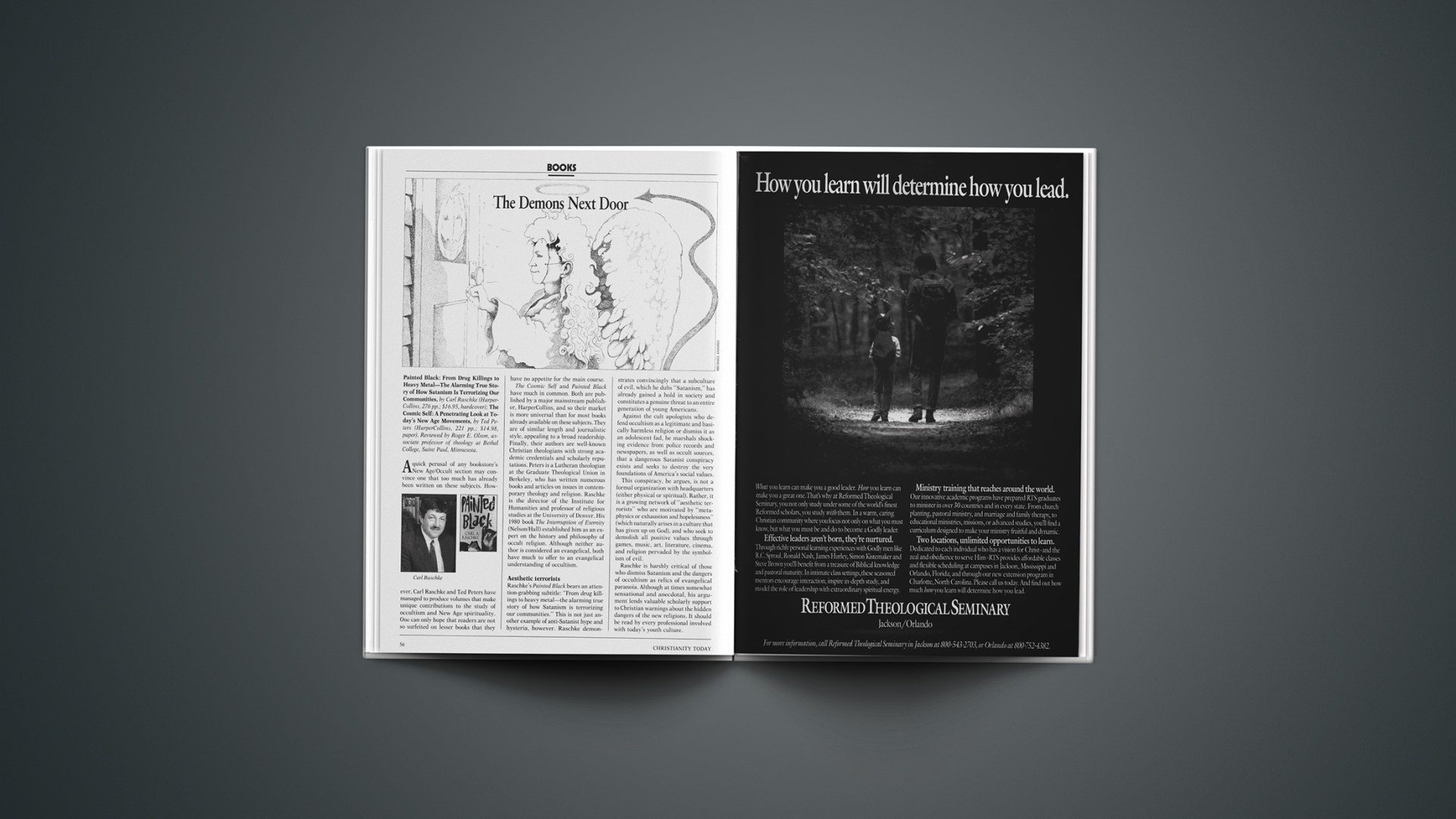Painted Black: From Drug Killings to Heavy Metal—The Alarming True Story of How Satanism Is Terrorizing Our Communities, by Carl Raschke (HarperCollins, 276 pp.; $16.95, hardcover);The Cosmic Self: A Penetrating Look at Today’s New Age Movements, by Ted Peters (HarperCollins, 221 pp.; $14.98, paper). Reviewed by Roger E. Olson, associate professor of theology at Bethel College, Saint Paul, Minnesota.
A quick perusal of any bookstore’s New Age/Occult section may convince one that too much has already been written on these subjects. However, Carl Raschke and Ted Peters have managed to produce volumes that make unique contributions to the study of occultism and New Age spirituality. One can only hope that readers are not so surfeited on lesser books that they have no appetite for the main course.
The Cosmic Self and Painted Black have much in common. Both are published by a major mainstream publisher, HarperCollins, and so their market is more universal than for most books already available on these subjects. They are of similar length and journalistic style, appealing to a broad readership. Finally, their authors are well-known Christian theologians with strong academic credentials and scholarly reputations. Peters is a Lutheran theologian at the Graduate Theological Union in Berkeley, who has written numerous books and articles on issues in contemporary theology and religion. Raschke is the director of the Institute for Humanities and professor of religious studies at the University of Denver. His 1980 book The Interruption of Eternity (Nelson/Hall) established him as an expert on the history and philosophy of occult religion. Although neither author is considered an evangelical, both have much to offer to an evangelical understanding of occultism.
Aesthetic Terrorists
Raschke’s Painted Black bears an attention-grabbing subtitle: “From drug killings to heavy metal—the alarming true story of how Satanism is terrorizing our communities.” This is not just another example of anti-Satanist hype and hysteria, however. Raschke demonstrates convincingly that a subculture of evil, which he dubs “Satanism,” has already gained a hold in society and constitutes a genuine threat to an entire generation of young Americans.
Against the cult apologists who defend occultism as a legitimate and basically harmless religion or dismiss it as an adolescent fad, he marshals shocking evidence from police records and newspapers, as well as occult sources, that a dangerous Satanist conspiracy exists and seeks to destroy the very foundations of America’s social values.
This conspiracy, he argues, is not a formal organization with headquarters (either physical or spiritual). Rather, it is a growing network of “aesthetic terrorists” who are motivated by “metaphysics or exhaustion and hopelessness” (which naturally arises in a culture that has given up on God), and who seek to demolish all positive values through games, music, art, literature, cinema, and religion pervaded by the symbolism of evil.
Raschke is harshly critical of those who dismiss Satanism and the dangers of occultism as relics of evangelical paranoia. Although at times somewhat sensational and anecdotal, his argument lends valuable scholarly support to Christian warnings about the hidden dangers of the new religions. It should be read by every professional involved with today’s youth culture.
Friendly Fire
The tone of Peters’s The Cosmic Self contrasts starkly with Raschke’s jeremiad. In part, of course, that is because it deals with a much less exotic and sinister manifestation of occultism. It is a sympathetic yet critical Christian analysis of the New Age movement. Unlike many evangelical books on this subject, it avoids polemics, affirming many of the values and goals of New Age philosophy and spirituality. On the other hand, Peters pulls no punches in pointing out the movement’s inner inconsistencies and fundamental incompatibility with the Christian gospel.
Peters’s basic thesis is that “neither a bald bashing nor a broad baptizing of the whole new age is the way to go.” A bald bashing is not in order because the New Age movement endorses and promotes such values as peace, love, and cooperation. Its basic vision is a noble and edifying one, and mere dabbling in it, according to Peters, is probably harmless and may even be helpful to some people. With this thesis many evangelicals will disagree, although even such a conservative New Age critic as Douglas Groothuis has written that all that is holistic is not hellish.
In spite of its cautious and irenic tenor, however, Peters’s is primarily a sustained argument against naïve blending of New Age with Christianity. Herein lies its greatest value. In speaking to church audiences, I have discovered a surprising openness to New Age ideas and practices among middle-age, middle-class Christians. Such people are often turned off by any critique that seems uninformed or closed minded. Peters is neither. Yet, especially in his final section, entitled “Testing the Spirits,” he starkly contrasts the naïve optimism of the New Age’s belief in our inner divinity with the realism and hope offered by the Christian gospel of grace. In the final analysis, he states, “The gnostic monism at the heart of new age teaching is dangerous because it leads to naivete and to a denial of God’s grace.”
Unlike many evangelical diatribes, Peters’s book makes this point in a way that those in the pews with New Age sympathies can accept. Like Raschke’s book, it is a true gift to all who are concerned about the growing influence of these occult phenomena in society.










